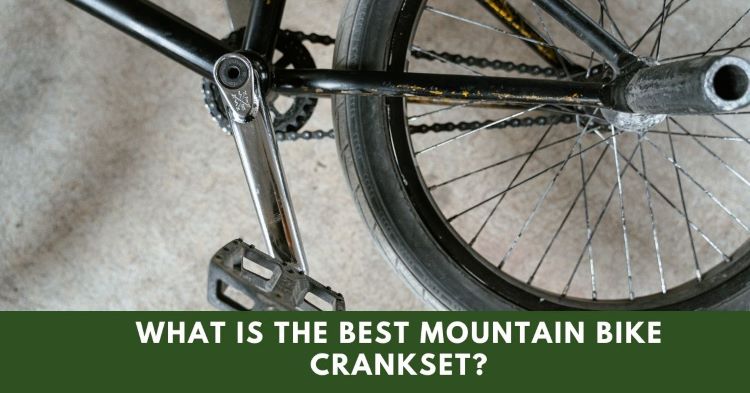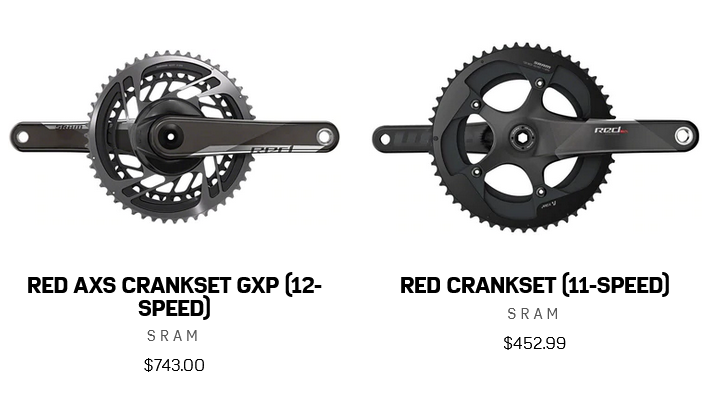Last Updated on July 15, 2024 by Emmanuel

So you want to change your mountain bike crankset but can’t distinguish the most suitable option? Let this detailed content help you decide which one is worth it.
Knowing which mountain bike crankset is best will aid in spending your hard-earned money wisely on the most suitable one; we will also show you a retailer that supplies these accessories at great prices in North America.
Table of Contents
Introduction to Mountain Bike Cranksets
Cranksets are the bike drivetrain components that convert the rider’s legs’ to reciprocate motion into rotational motion and drive the belt or chain to move the wheels.
These parts contain one or more chainrings (sprockets) and crank arms. The manufacturers typically tie them to cranks to which the pedals attach.
To upgrade your current crankset, purchase a set of chainring and crank or buy both parts separately.
Later on this page, we will show you the most important things to consider when buying a crankset to upgrade your chainset.
We will end this section by saying that if you are in the United States, you can call these parts “cranksets,” while people in the United Kingdom call them “chainsets.”
Is It Worth Upgrading a Mountain Bike Crankset?
Upgrading your mountain bike crankset or not depends on your riding goals and the experience you expect from your MTB, but we encourage you to do it.
After upgrading the crankset of your MTB, it will become lighter, enable your smooth shifting, and allow you to enjoy the best riding experience.
You can also upgrade the chainset of your bicycle to give it a good appearance, but we don’t think this is a priority.
Other people ask when to upgrade their bike’s crankset, what to look into when buying a new one, etc.
Check if your bike’s chainring and other components are still in good condition or worn so you can replace them on time.
If, for example, you notice that the crankset’s chainrings look scattered, things are getting worse; it is time to replace the worn chainring.

Where Can You Find Top-Rated MTB Cranksets?
Many retailers supplying bicycles, parts, and accessories typically have a wide array of cranksets: select the most appropriate for upgrading your bike.
We recommend Mike’s Bikes, one of the best US retailers of everything related to bicycles since the early 1970s.
Besides, all types of cranksets, Mike’s Bikes sells many bicycles from big brands such as Cannondale, and Giant.
The owners have also partnered with top manufacturers of high-end bikes, such as Gazelle, Juliana, Liv, Specialized, Santa Cruz, Public, Momentum, etc.
So, whether you want to buy a Shimano mountain bike crankset to upgrade your bike and have the budget to acquire a new MTB, Mike’s Bikes has all you need.
You can even buy road, active, or electric bikes at great prices at this retailer’s online shop.
Also, Mike’s Bikes online shop has GPS, water bottles, bike racks, bags and panniers, cargo accessories, and many otehr accessories.
You can even purchase biking apparel such as base layers, bibs, casual wear, jackets, jerseys, pants, shorts, tights, vests, etc.
How Can You Choose Quality Mountain Bike Cranksets?
Now that you know where to buy MTB cranksets online, you can ask the criteria for choosing the best one.
First, be aware that you can differentiate MTB cranksets by their bottom bracket, number of chainrings, and crank length.
The average length of an MTB crank is 175mm long, but you can still choose a shorter or longer crank for a more comfortable ride, depending on your body size.
Another essential criterion is the crank material, as most MTB cranksets are made of aluminum and carbon fiber for weight savings.
It will also help if you look into the bottom brackets and see if they are of a modern external setup for less weight and more stiffness or older cartridge.
Also, you can consult with a bike professional if you don’t know enough about these accessories; it will avoid your late inconvenience.

How Can You Measure a Bicycle Crank Properly?
The size of bike cranksets varies between 160mm and 185mm, depending on whether a bike is small or big.
However, many people find it challenging to figure out their bikes’ crank length; if you are one of them, look at your crank’s backside.
The manufacturers typically engrave the length of cranks below the pedal axle. It is where you will find yours quickly.
If you don’t find the size of your crank at this location, use a tape measure to measure your bike’s crank.
You can take your bicycle’s crankset from the center of the pedal axle to the center of the bottom bracket spindle.
Also, the nine best QuietKat electric hunting bikes are worth checking if you need a top-rated MTB for hunting safely.
What Do Crankset Numbers Mean and Are They Worth It?
Please don’t stress yourself when you see numbers like 53×39 or 50×34 on your bicycle’s chainring because they are easy to understand.
The numbers on your bike’s chainring, whatever the type, refer to the number of teeth on each chainring.
For example, a compact crankset features 50 and 34 tooth rings; a standard one has 53 and 39 tooth rings.
However, don’t think that the more teeth are on the chainring, the better you can become a successful runner.
Each crank has pros and cons, but we will not enter into the details of this debate as it can take longer and overwhelm you.
Should Taller Riders Use Longer Cranks?
It will help if you are careful enough when choosing the cranks of your bike to avoid injuries and cycling discomforts, especially when you usually cycle long distances.
Ensure that your bike’s cranks are proportional to the length of your legs. The handlebar reaches and saddle height must be proportionate to your body’s other dimensions.
Below is a summary of the recommended cranks length:
- Cranks up to 160mm are suitable for people shorter than 1.65 m (5’5″), but you will unlikely find many of these types on the market.
- If your height is between 1.65 m (5’5″) and 1.72 m (5’8″), you will do better to choose a bike featuring cranks of 165 mm to 170 mm.
- The ideal crank for people whose height is between 1.72 m (5’8″ and 1.78 m (5’10”) is 170 mm.
- If you measure between 1.78 m (5’10”) and 1.90 m (6’3″), your best bike’s cranks are 172.5 or 175 mm.
- Finally, we recommend individuals taller than 1.90 m (6’3″) choose 175 mm cranks or longer.

Will Shorter Cranks Help My Knees?
Shorter crank arms have many benefits over longer ones as some riders suggest but we are unsure to give our honest opinion.
We can only tell that equipping your bicycle with shorter crank arms can lower the knee at 7.5 mm maximum flexion.
A shorter crank arm will enable you to sit 7.5 mm too low in the saddle, and the bike fitter will raise your saddle by 7.5 mm.
It will result from the rise of the saddle that your knee will be at maximum flexion, which will lower the hyperflexion’s severity by 3° to 4°.
What Is a Q Factor Crankset?
The Q-Factor refers to the distance between the pedal attachment points on the crank arms; many also call it the Tread.
You can also consider the Q-Factor as your crankset’s width, which affects your stance,
If, for example, you ride a mountain bike that typically features cranks 20mm wider than those of road bikes, you will have a wide tread or a more significant Q factor.
Your MTB will enable you to make less cornering clearance when pedaling for the same crank arm length and bottom bracket height.
According to the University of Birmingham in the United Kingdom, narrower Q factors are more efficient.
They would provide the rider with an improved application of force during the pedal stroke and reduce the knee variability and risk of injury.
The Content Final Thoughts.
That’s what we can tell about the “What is the best mountain bike crankset?”; we hope this content is helpful to many riders who ask this question.
Also, we have provided links to the online shop of one of North America’s best cycling retailers.
Mike’s Bikes supplies top-rated road bicycle cranksets, MTB cranksets, bicycles, apparel, accessories, etc.
Leave a Reply